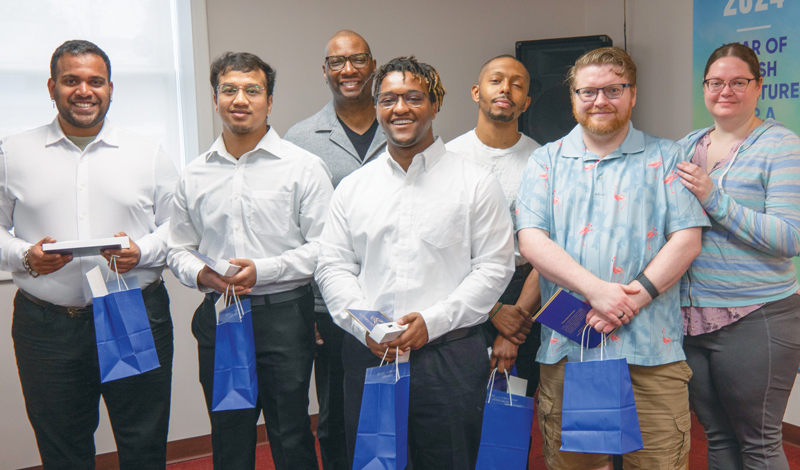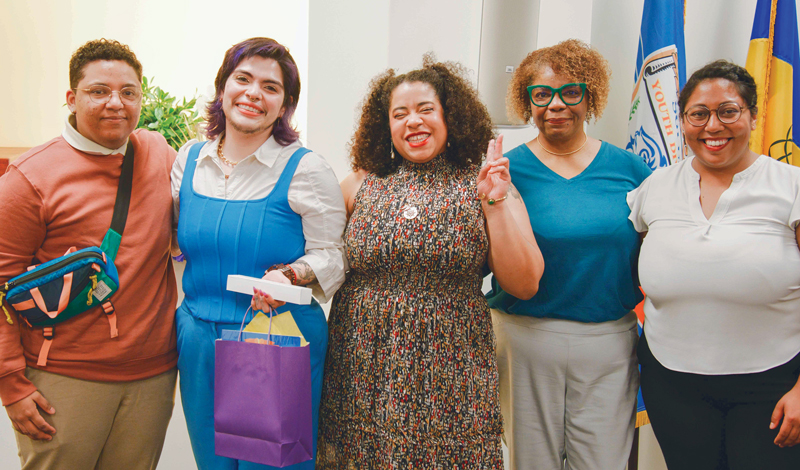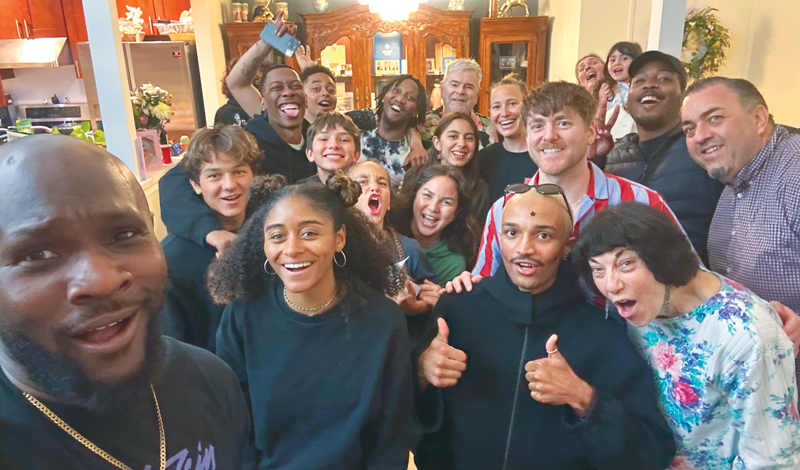SANTA MONICA, Calif.—On Oct. 2, 2020, SGI-USA marked the 60th anniversary of our kosen-rufu movement by outlining a vision toward 2030 that includes making Nichiren Buddhism and the life-affirming philosophy of Soka a part of mainstream American culture.[1]
Referring to that long-term aim, SGI-USA General Director Adin Strauss recalled how, Ikeda Sensei, during one of his U.S. visits, shared with those working behind the scenes that he always treats everyone the same; he is the same person regardless with whom he speaks.
“This was a point of reflection,” Strauss said. “We should be exemplars of the concept of consistency from the beginning to end: This means that the person who shows up in the district should not be different from the person who shows up at work, in their family and in the community. That is actual proof of Buddhist practice.”
The concept of rooting ourselves in the community—using the training we gain through our Buddhist practice and SGI activities to become trusted community members who create great value where we stand—was the centerpiece of the SGI-USA Central Executive Committee’s second quarterly conference, held June 8 at the SGI-USA Headquarters with the national and territory four-divisonal teams.
The daylong meeting took place at the start of the Summer of Shakubuku, a concentrated, chapter-led effort from June to August to spread Buddhism in local communities as a means for transforming the trajectory of our country.
In his opening words, Strauss said that the Summer of Shakubuku starts with each person’s awareness as a Bodhisattva of the Earth, citing a passage from volume 23 of The New Human Revolution, where Sensei explains that it means “knowing the true and fundamental purpose of life—being born with the mission to strive for the happiness of others—and putting it into practice”[2] (see sidebar). “Let’s think about this as our personal mission,” Strauss said.
Knowing Our Mission as Bodhisattvas of the Earth
Nichiren Daishonin writes, “If you are of the same mind as Nichiren, you must be a Bodhisattva of the Earth” (“The True Aspect of All Phenomena,” The Writings of Nichiren Daishonin, vol. 1, p. 385). This awakening is the starting point of the conviction of the Soka Gakkai, the organization in complete accord with the will and decree of the Buddha, directly linked to the Daishonin and dedicated to kosen-rufu. The awareness of the mission of the Bodhisattvas of the Earth is knowing the true and fundamental purpose of life—being born with the mission to strive for the happiness of others—and putting it into practice. It is the source for creating the absolute maximum value in life. It is the activating force for establishing a greater self that embraces all peoples and indeed all humanity through transforming the petty life state of the lesser self, concerned only with its own interests and cares, into the wish to help others. In other words, dedicating oneself to the mission of the Bodhisattvas of the Earth is the path of human revolution.
Because of the mood of helplessness and depression and the failure to apprehend the true meaning of life that prevailed among young people at the time, Shin’ichi wished to make a vigorous appeal to youth about the purpose of living. (The New Human Revolution, vol. 23, pp. 243–44)
When it comes to rooting ourselves in the community, he said it doesn’t mean to volunteer or hold interfaith dialogue, as noble as those pursuits are, but rather, to make real individual connections with those around us and show actual proof as human beings based on our Buddhist practice.
“When 10,000, 30,000 and 50,000 members show great actual proof of human revolution—this is how we bring the SGI-USA into the mainstream,” he said. “This effort is rooted in the tens of thousands of inconspicuous, humanistic actions we take on our part. This is crucial.”

The starting point for kosen-rufu exists in the shared struggle between mentor and disciple.
In a message to the CEC, Soka Gakkai President Minoru Harada wrote that June is the month of Tsunesaburo Makiguchi’s birth as well as the Soka women’s division’s founding. It is also the month when Ikeda Sensei on June 20, 1981, dedicated the poem “To My Beloved Young American Friends—Youthful Bodhisattvas of the Earth” to the SGI-USA.
President Harada said the starting point toward the realization of worldwide kosen-rufu exists nowhere but in the struggle of mentor and disciple shared between Sensei and each of us, the members of America. He underscored this point by sharing the conclusion of Sensei’s June 1981 poem, which reads:
I entrust to you
the entire endeavor of kosen-rufu …
Confident that
from this yet narrow path
you will forge a grand passage
into the future,
I am happy and filled with joy.[3]
Spreading circles of ever-widening trust and understanding is the key to expanding our movement.
During a session on the Summer of Shakubuku, the representative leaders discussed the importance of having deep conviction that our actions for kosen-rufu will indeed shape the future of humanity.
To that end, SGI-USA Men’s Leader James Herrmann said it’s important to convey our passion for kosen-rufu. “Am I just checking my own boxes, or am I passionately sharing this sense of mission?” he asked. “We need to inspire members who are filled with a desire to help humanity.”
SGI-USA Executive Advisor Danny Nagashima shared a report on the efforts of Marianas Region to spread the light of Buddhism in their local communities.
The region leadership team united last spring around milestones for planting seeds of the Mystic Law, doing home visits, introducing new members, subscribing to the SGI-USA publications and increasing the number of people who attend Soka 2030 and kosen-rufu gongyo meetings on Sundays.
“We determined that everyone would fully enjoy this process,” he said. “We didn’t want to do it out of desperation but out of joy.”
Soon after, in May, Typhoon Mawar attacked the island, destroying homes and knocking out power to the island. Nagashima said the local leaders visited one person after another and rekindled their fighting spirit to advance kosen-rufu with Sensei. They also began sharing Buddhism each Saturday at a local farmer’s market, sharing Nam-myoho-renge-kyo with more than 19,000 people, or over 10% of the population of Guam, in just 16 months.
The region also deepened their ties to the community, meeting with eight high school principals to promote the SGI-USA’s peace movement in Guam and Soka University of America. On June 9, they welcomed more than 200 guests to the SGI Guam Ikeda Peace and Culture Center for a performance by the Tumon Bay Youth Orchestra, which is composed of musicians 25 years old and younger, run by the Guam Philharmonic Foundation.
Nagashima said the members there are striving to live these words by Sensei:
In addition to being good practitioners of Nichiren Buddhism, I hope you will also be good neighbors, good citizens and good members of your local community and society. May you win the praise, respect and trust of others through such behavior. Spreading circles of bright, deep, ever-widening trust and understanding is the key to expanding our movement for kosen-rufu.[4] (see sidebar).
Buddhism Comes Alive Through Our Behavior as Human Beings
Becoming people who are trusted, respected, and liked by all—indispensable people who are needed at home, at work and in our community—is the way to show the validity of our Buddhist practice and advance our movement for kosen-rufu. …
Even if we are subjected to unfounded criticism or attack, we should remain undisturbed and keep living our lives in the right way. By doing so, we will win the praise and respect of others in the end.
It is in our behavior as human beings that the teachings of Buddhism come alive and actual proof of our Buddhist practice is revealed. Our courteous, humane conduct can be said to be an expression of correct faith.
In addition to being good practitioners of Nichiren Buddhism, I hope you will also be good neighbors, good citizens and good members of your local community and society. May you win the praise, respect and trust of others through such behavior. Spreading circles of bright, deep, ever-widening trust and understanding is the key to expanding our movement for kosen-rufu. (The Wisdom for Creating Happiness and Peace, part 2, revised edition, pp. 100–01)

Strengthen the spirit of meeting face-to-face in the district.
In another session, the representatives discussed ways to inspire more discussion meeting participation, so that members can chant daimoku together and connect life-to-life.
One person relayed guidance from Sensei, in which a young man suggested to first Soka Gakkai President Tsunesaburo Makiguchi that holding large-scale lectures would be more effective than one-to-one dialogue:
“No, it wouldn’t,” Mr. Makiguchi replied without hesitation. “Dialogue is the only way to communicate with another about life’s problems. At a lecture, listeners inevitably feel uninvolved. Even [Nichiren] Daishonin’s treatise ‘On Establishing the Correct Teaching for the Peace of the Land’ was written in the form of a dialogue.”[5]
The CEC members voted to minimize the use of Zoom moving forward and emphasized that we share through home visits the joy of attending meetings in person with our comrades in faith.
Herrmann said that meeting in person requires more effort but it conveys the Buddhist spirit to “discard the shallow and seek the profound,” which Sensei elaborates on in a lecture:
In these compassionless and self-centered times, where people are only concerned about themselves and give little thought to others, we of the SGI have chanted for the happiness of our friends, prayed for the prosperity of our local communities and society, and wholeheartedly exerted ourselves for kosen-rufu. …
Life, too, is a struggle. We need to defeat our weaknesses and courageously stand up, based on faith, with the resolve to continue growing in our lives, to keep moving forward and to be victorious in the challenges we encounter. When we live with such depth and meaning, we can become true winners in life. That is the purpose of our daily practice of faith and our SGI activities.[6]
Create a wave of joy in our communities.
In closing encouragement, SGI-USA Women’s Leader Naoko Leslie expressed her appreciation to everyone for their support of the May Commemorative Contribution activity, which she said was based on “one-to-one, heart-to-heart encouragement.”
She then touched on the Kamata Campaign, in which Sensei, as a youth, led the members of Kamata Chapter in introducing 201 families to Nichiren Buddhism in a single month, breaking all previously perceived limits to propagation. This was the beginning of the “February Campaign” tradition that we still commemorate today.
In an essay on that campaign, Sensei shared the three points they focused on:
1. Let’s start with chanting Nam-myoho-renge-kyo.
2. Let’s treasure our neighbors.
3. Let’s share our experiences in faith.
She also touched on the August 1957 propagation campaign that Sensei initiated in Tokyo’s Arakawa Ward, where more than 200 people joined the Soka Gakkai in a single week.
She relayed an episode in volume 26 of The New Human Revolution, where a leader asks Sensei [appearing in the novel as Shin’ichi Yamamoto] what was the driving force for that campaign:
Shin’ichi [Yamamoto] replied without hesitation: “It was the single-minded wish for each person to become happy. At that time, everyone was overwhelmed by their own karma—struggling with problems such as poverty, unemployment, sickness and family discord.
“I met with members and continually tried to impress upon them that the only way for them to break through and transform their karma was to awaken to their mission as Bodhisattvas of the Earth and make great efforts for kosen-rufu.
“Though the period of the campaign was brief, the members chanted intensely with the determination that they would use the campaign to share Nichiren Buddhism with many others and to overcome their problems. They challenged their problems courageously and strove all out. They made efforts not because they had been told to but because they were driven by a fighting spirit that welled forth from the depths of their lives.
“The purpose of our faith and Soka Gakkai activities is to become happy. They’re all for our own benefit, which in turn leads to prosperity in society.
“Throughout the campaign and afterward as well, I received reports from many members about the benefit they experienced in having surmounted their hardships.”[7]
Leslie shared how, after moving to a new city, she determined to help 10 people begin practicing in her community. Through her efforts to plant seeds, continually visit those she has introduced to the SGI-USA and chant for their growth and victories, she is within sight of her goal. “Let’s create a wave of joy in our communities!” she said, returning to Sensei’s guidance on this point:
“People with whom you share a profound karmic connection, who are ready to “spring from the earth,”[8] are waiting for you to talk with them. They are waiting to hear your confident voices.”[9]
June 21, 2024, World Tribune, pp. 6–8
References
- Oct. 2, 2020, World Tribune, p. 40. ↩︎
- The New Human Revolution, vol. 23, p. 243. ↩︎
- The Sun of Youth, pp. 74–75. ↩︎
- The Wisdom for Creating Happiness and Peace, part 2, revised edition, p. 101. ↩︎
- Feb. 17, 2006, World Tribune, p. 3. ↩︎
- The Opening of the Eyes: SGI President Ikeda’s Lecture Series, p. 83. ↩︎
- NHR-26, 315–18. ↩︎
- A line from an impromptu poem composed by Ikeda Sensei on Aug. 14, 1947, when he first met Josei Toda, who came to be his lifelong mentor and later second Soka Gakkai president. ↩︎
- Nov. 4, 2022, World Tribune, p. 3. ↩︎
You are reading {{ meterCount }} of {{ meterMax }} free premium articles

